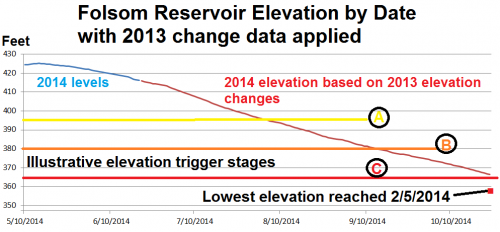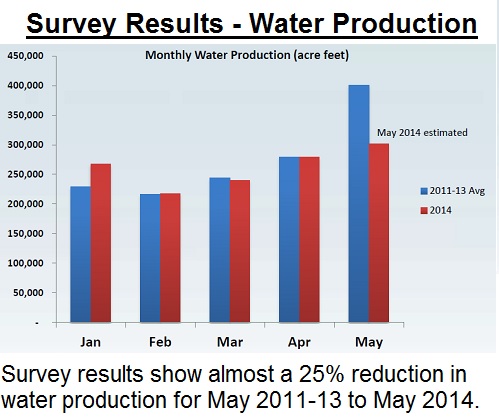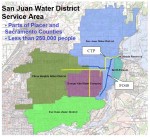With Folsom reservoir dropping to historically low levels in the autumn of 2013 and record low rain fall, there was no question that Northern California was in the grip of a drought. The question posed by San Juan Water District Board member Bob Walters to the assembled drought water committee at their second meeting was, “What triggers the SJWD Board to declare additional water conservation stages and pricing measures?” Perhaps struck by the acknowledgement that there was no specific guideline for mandating water conservation, the normally talkative group was pushed into a pondering silence.
What triggers drought stages for Folsom Lake?
The excellent question about what triggers mandatory water conservation measures is inherent to the mission of the drought committee as they make recommendations for additional water savings to the SJWD Board. More specifically, what conservation measures will cause the least amount pain to the consumers while saving the most amount of water? If the recommended water conservation measures are successful, the SJWD Board will not have to contemplate additional mandatory watering restrictions.
Drought Committee Meeting, June 2014
In attendance at the second meeting were representatives from Orangevale Park District, San Juan School District, Granite Bay Golf Course, the pool construction, real estate and landscape professions along with local residents. SJWD was represented by Water Resources Analyst Vicki Sacksteder who facilitated the meeting, Board members Pam Tobin and Bob Walters, and a representative of the district’s public relations firm.
Can Folsom Lake level trigger water conservation?

Is the lake level low enough to trigger conservation measures yet?
The answer to the question of what triggers additional declarations of water conservation measures seemed to be the level of Folsom Lake. A lake level trigger seemed most obvious for district consumers whose sole source of water is from the reservoir. Other areas such as Citrus Heights and Fair Oaks, who also purchase water from SJWD, will have a greater tolerance for lower lake levels. Several of the water districts who purchased treated water from SJWD also have their own municipal wells which they can rely on when Folsom Lake water becomes a scare commodity.
Folsom inflow, releases and diversions
What the SJWD watches closely is the rate of drawn down of Folsom Lake relative to current reservoir capacity and the time of year. Given a low water level at the beginning of the irrigation season, there are several factors or inputs that go into the calculation of determining the rate at which the reservoir will drop. In addition to releases by the Bureau of Reclamation for environmental considerations, downstream users such as the City of Sacramento and Delta salinity control, there are also the diversions by the City of Folsom, City of Roseville and the SJWD.
Drought stage declarations
All of these demands, plus incoming water flow from the North and South Fork of the American River combine to determine the relative rate at which Folsom reservoir will drop in elevation. In the absence favorable climatic conditions, such as rainy cool weather, water conservation stages are triggered by the reservoir level. Last year SJWD declared a Stage 2 Water Alert and eventually a Stage 3 Water Warning. These declarations were based on calculations of current Folsom Lake releases, diversions and anticipated inflow from precipitation.
High tides and levee failures
Just contemplating the multiple scenarios that might lead to accelerated water releases or diversions illustrates how having a hard elevation number as a trigger may be either too optimistic or overly cautious. It has been reported that Bureau of Reclamation (BoR) was increasing releases to blunt salinity intrusion in the Delta brought on by high tides. Other sources of unanticipated demand on Folsom Lake water may occur if one of the municipal water wells in the area served by Folsom Lake fails or a natural disaster such as a 2004 Delta levee failure necessitates more water releases.
Folsom Lake level framed in conditions
Not every accelerated demand scenario can be built into a forecasting model. But having a conditional decision point would provide a framework for when the board might discuss and vote on the conservation measures. In other words, certain conditions would have to be met in addition to the water level before the SJWD Board would have to consider implementing the next drought stage. Conditions such as
- Low water elevation levels occurring in the peak irrigation months: April through October
- Inflows are below historical averages
- Reservoir elevation has peaked and is now declining
- Snow pack is estimated to be below a certain percentage of normal
- There is the possibility that the rate of elevation decrease will increase at an increasing rate: natural disaster, unforeseen environmental demands, etc.
What does a lake level trigger curve look like?
A hypothetical application for reservoir levels as conservation triggers is illustrated in the graph below. The blue line represents Folsom Lake elevations based on reported data from the Bureau of Reclamation from May 10th to June 20th. The lake elevation peaked on May 16th and then started to decline. The red line represents a hypothetical lake level based on the change of lake level from the same period in 2013. I don’t anticipate the total of BoR releases combined with water agency diversions to be the same since SJWD has already reduced their diversions by over 30% from last year. But as mentioned earlier, there may be unforeseen situations that require either the BoR or the water agencies to increase their water usage. The lowest lake water elevation occurred on February 5th before the region started to experience a series of winter storms. (All data was gathered from http://cdec.water.ca.gov/index.html a Bureau of Reclamation data exchange website)

Folsom Lake elevations could trigger mandatory conservation.
Drought Stages A, B, C
Water elevations A, B, and C might be trigger points for either the established water conservation stages or some other notification process. Any water restrictions would still have to be approved by the SJWD along with any rate increases to offset declining revenue. But any published elevation trigger point would be helpful to water consumers as a guide to where the district sits in relation to a dwindling pool of available water.
Where does the conserved water go?
There was also the realization amongst the drought water committee that enhanced water conservation will increase the amount of water available to be released for environmental concerns by the BoR. This also exposed a small but growing sentiment of “why should I conserve if the Bureau of Reclamation is just going to release the water anyhow.” Since perception is reality, this is an area that the SJWD Board and staff will need to carefully consider if they want to maximize “voluntary” water conservation efforts.
Journalists jump to conclusions
The drought committee’s work along with the Board’s is made incrementally more difficult when poor reporting on partial water conservation data creates misconceptions. The Sacramento Bee headline Report: California has a long way to go on water conservation left the impression that parts of California were shirking their responsibility to conserve water during the drought. Not all communities can conserve 20%. The Central Coast and Colorado River basin already have low residential water use by nature of having very little water. Download the full presentation at the end of the post.
But beyond the sexy headline the survey data is incomplete. Only 270 of the 443 water districts responded to the survey. There was no data released about the different types of the districts or their water sources.
- Are the respondents: urban, suburban or rural?
- Do they rely on ground water, surface water or a combination?
- How many surveys were from each of the different water regions?
In short, there is very little in the released data that gives anyone any indication of how well Californians are conserving water. For a state that doesn’t even monitor how much ground water is being used to service either agricultural, commercial or residential consumers, the State Water Resources Control Board is in no position to pass any judgment on how well we are conserving.
San Juan Water District exceeds conservation production
Vicki Sacksteder did inform the drought committee that SJWD had reduced water consumption by 32.4% for the period coinciding with the water district survey. The conservation of the SJWD is directly in-line with estimated 25% decrease in water production reported in the water board survey results.

California has reduced water production by 25% which is truly conservation.
Educating regulators about SJWD
Board member Pam Tobin gave a synopsis of her testimony at the last state water board meeting. She also solicited for volunteers to attend the next meeting with her on July 1st. The goal of SJWD’s presence at the next water broad meeting is to encourage the state to apply more pressure to the Bureau of Reclamation to place more emphasis on immediate future water availability for the local region. While it is understood that the Bureau is under considerable pressure to serve a variety of interests with their releases from Folsom reservoir, the local economy should hold an equal or greater position within the calculations for managing Folsom Lake releases.
Is Northern California doing enough to conserve?
This discussion segued into general impressions about the Metropolitan Water District (MWD) that holds unprecedented influence at the state level. Most notably was the implementation of household water budgets in the MWD district based on house size, lot size and other appurtenances such as a pool . The water allotment based a number of factors then governs the base line water volume to maintain a healthy home and landscape. Households that exceed the budget have their water usage in excess of the monthly allotment billed at a higher rate.
Auburn Dam
Before anyone paints MWD as part of the evil water cabal, we should remember that the SJWD has its roots in numerous dams built on the North Fork of the American River near Auburn in the 1850’s when water rights were often negotiated with the barrel of a gun. And similar to MWD, the owners of the Birdsall Dam and North Fork Ditch, predecessors to the SJWD, were sued in 1898 by the owners of the Folsom Power House for diverting more than their fair share of the river.*
Household water budgets and economy of scale
Such household budgeting, as noted by Vicki Sacksteder, is expensive to implement. But equitable water rate criteria that deliver significant conservation based on pricing mechanisms holds particular value to state regulators. The other issue is that MWD can consider and implement such expensive measures because their economy of scale by virtue of their service area. MWD serves 18 million people over a six county region. By comparison, SJWD serves less than 250,000 people over a two county area.
Click to enlarge thumbnails
The next meeting will focus on specific water conservation efforts to implement if SJWD has to declare a Stage 4 short or long term water crisis.
*150 Years of Water: The History of the San Juan Water District, Water Education Foundation, 2004
[wpfilebase tag=file id=41 /]




